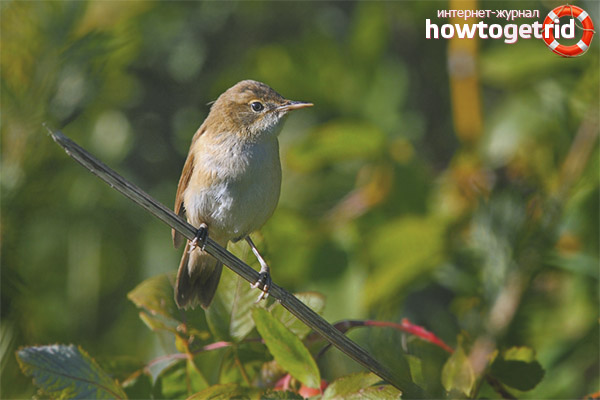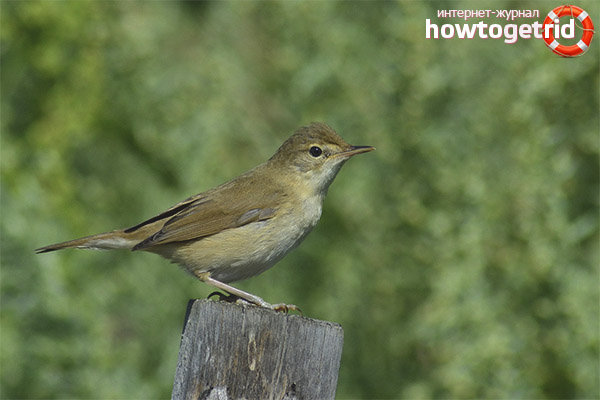The content of the article
The reed garden is a songbird that can be found in Belarus, Russia, Ukraine, India, Kazakhstan, Turkmenistan.
The garden view is practically no different from reed and swamp reeds. They all look almost the same - the length is from 10 to 18 centimeters, the size of the wings is from 5 to 7 centimeters, and the weight is about 10 - 17 grams.
A bird called reed cannot boast a bright color, on the contrary, both the male and the female have the same gray-brown coloration at the top and olive-beige in the lower parts of the body. The most important feature of garden birds is their imitation singing, which they publish at night. These song creatures mimic the sounds of other birds and do it much more slowly than their swamp counterparts.
Appearance Features
Mature reeds during the mating season look special. In general, the back of these birds is painted in a deep olive color. But the supraxtral part is a bit lighter than the olive back, but the tail and wings, on the contrary, are worked even deeper and therefore look very dull.
Gray, smoky color prevails on the prominent side of the bird, it extends from tail to throat. Also gray is found on claws and fingers.
In the summer, this feathered songwriter looks rather gloomy. It is in a molting form that the whole color dullness of this bird is visible - the back is gray-brown, the belly is dirty-whitish. But mature individuals in a new autumn guise can boast of reddish flowers on the dorsal side and an admixture of ocher on the abdominal part of the body. Young animals in autumn have a brighter and more reddish color than adult individuals.
Habitat
The garden bird, as already discussed above, lives in many countries; it is sometimes found not far from Leningrad, in eastern Estonia, in the West Siberian swamps, in Mongolia, Altai, Irtysh, Nepal, and Saratov. Goes to India for wintering, Pakistan and other thermal countries.
A feathered traveler enters the territory of the former USSR only in the summer season. This is a flying view that does not linger in our area for a long time.
First meeting
In 1901, the first garden reed was discovered on the territory of the former USSR; it was spotted on March 10-13 in the Murghab Valley. After the migration of birds was noticeable - at the end of June they began to prepare for the autumn departure from the USSR, but finally left the CIS in August-September 1901.
Experts noticed that the birds began to gradually fly away from the USSR, so these birds on August 24 began to fly away from the Moscow Region and by September 9 they had almost never met in the capital's outskirts.
Behavior
Garden reed is considered a lover of the forest, it prefers deciduous or coniferous areas of the forest. In general, the bird is nomadic and adapts to a variety of conditions and climatic landscapes.
In the taiga often creates nests in shrubs and in the meadow space, which is located near swamps, lakes, rivers, canals. Also, its presence can be observed in overgrown raspberries, in small pits, in bushes and ravines.
In the forest-steppe region, it wanders in small, birch forests and sometimes comes across a completely extraordinary area (where there are no trees and shrubs). Bulrushes in open, dry locations settle near water bodies, slightly overgrown with small reeds and rivers, but only in places with bushes or reeds.
At streams and small rivulets, it occupies areas in willow and alder forests.Lives on hillsides in thickets of bushes, and sometimes in reeds fences sometimes located far from water. Sometimes it settles in social, abandoned places - these can be weedy gardens, abandoned parks, ditches, overgrown gardens, especially those located near ponds and rivers.
The mountainous territory was also chosen by the singer, it populates the density of rose hips and uncultivated types of cherries. Located on the slopes of valleys and hills. As for the mountainous terrain, then the reed prefers to nest at an altitude of 800 - 1300 meters. It lives on the plateaus of the Urals, on the Tien Shan and at the mountain streams of Kopetdag.
Population
The number of reeds varies and directly depends on the terrain. It is few in the northern parts, for example, it is difficult to find this bird in the Leningrad region or the Yenisei valley. But quite usually you can meet a songbird in the Urals, the Baltic states, in the Smolensk region and the Olonets region, as well as in the entire middle European region of the former USSR.
Breeding
In spring, birds return to nesting sites. Mature males upon arrival begin to sing and occupy nesting places. The nests themselves are at a different distance from water bodies, in some cases quite far. They are found in dense nettles, jasmine bushes, overgrown berry bushes, in wild rose, in cherries and other vegetation.
The most important thing for reeds when choosing a location for a nest is the presence of density in the vegetation and a lot of light on the particles of this very vegetation. A bird hangs nests on stems and branches, while the shape of the nest is usually either conical or cup-shaped.
The female lays from 4 to 6 eggs, quite variable in their color. The first type of eggs is covered with pale pink tones, the background of the second eggs in a dull, milky-white color, and the third is presented in a gray-white version.
Molting
These birds change their plumage twice a year. First comes the prenuptial, and after the postnuptial change of plumage. The first molt occurs in the winter, and the second in the fall. However, in young individuals there is partial molt in the final stage of summer.
Sound habits
Darkly brown in the top and grayish in the lower sector, she, the reed issues a double or triple call "check", signaling some kind of event. The feathered song is unique, it is difficult to confuse it with another. It consists of separate cries and syllables, and each of them is followed by the famous and repeated “check-check-check”.
During the mating season, you can constantly hear the singing males, they vote for days. Despite this fact, the males give out completely different songs in character, for example, in the daytime a rhythmic, fast song is heard, which happens without pauses. This is due to the fact that the bird does not sleep at this time, it searches for food, changes its position and performs many physical operations.
At night, the bird is passive and publishes its song from one place, usually sitting on the top of a bush or branch. The night song has calmness, slowness and high volume, also there are pauses and measuredness in it.
Video: garden reed (Acrocephalus dumetorum)












Submit